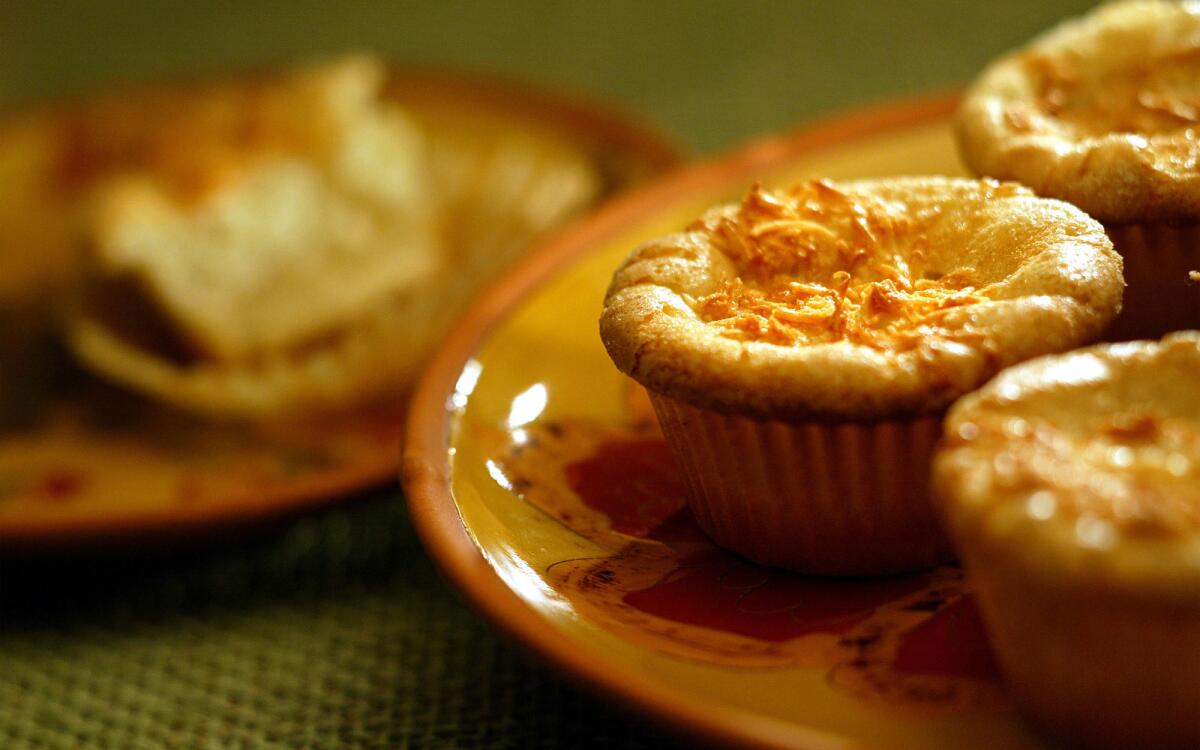Coconut cupcakes

Last year around this time as I passed a neighbor’s house, a powerful sense of deja vu overwhelmed me and, out of nowhere, I was filled with pleasant memories of island vacations. Hawaii? What was it about this unremarkable stucco house with the sago palm and high hedge?
The green shrub surrounded by fallen yellow fruit -- that was it. Some of the fruit had squashed when it hit the sidewalk in front of me, and the air was filled with an aroma so evocative of the tropics it made me want to run home and slip into a sarong.
Shamelessly I gathered the windfall fruit, scrabbling under the hedge on my hands and knees and filling my pockets with what I eventually identified as a kind of guava. (I was glad the neighbor didn’t appear. I didn’t feel criminal, but I couldn’t quite imagine explaining why my covetousness was causing me to root around in this forgotten corner of their yard.)
At home, I was at first thrilled with the pretty pink flesh inside the luscious-smelling fruit, then disappointed because there were so many seeds and so little pulp. The guavas didn’t taste at all like they smelled but were bitter, almost astringent. But I experimented a bit and discovered that they made a delicious preserve -- deep persimmony-orange in color, with a texture like apple butter and a fruity essence that lingers on the tongue.
I still have some jars of my road-kill guava butter, so this year when the tropical hankering hit me as I passed my neighbor’s house, I decided not to repeat my urban foraging but instead to head for the produce market. No doubt I’d be able to find some interesting recipes using whatever tropical fruit I turned up.
Tropical fruit is available year-round, of course, but supplies vary with the growing seasons. Have you noticed the mini Sugar Loaf pineapples from Maui that have just come to town? They’re sweet and meaty, and you can eat all the fruit, including the tender core. Big Maridol papayas from Mexico, with dark orange-hued flesh, are in markets. Mangos -- sweet, with a nice hit of acid and not too fibrous -- are coming in from Peru at the moment. Passion fruit, those wrinkly little purple guys filled with an intensely tropical flavor, are around for a short time too. And young coconuts, with flesh that’s softer, sweeter and milkier than the mature ones, are showing up; a few Latin markets even sell them with the hard shell already chiseled off.
It wasn’t hard to turn up compelling recipes.
From Miami restaurateur Norman Van Aken’s book “New World Kitchen” (Ecco, $34.95) I found one for parfaits of candied papaya, a Venezuelan delicacy. I couldn’t quite figure out what it was, so I just had to try it. Fresh papaya strips are simmered in a syrup made with piloncillo (solid brown sugar available in Latin markets) then chilled and layered with queso blanco and garnished with toasted coconut and an improvised creme fraiche. The combination of lightly preserved fruit and lightly salty cheese is delicious, as it turns out -- not unlike Manchego cheese served with membrillo (quince paste). And the papaya can be made ahead and kept in the refrigerator.
Nancy Silverton’s unusual recipe for coconut cupcakes is in “Cooking From the Heart” (Broadway Books, $29.95), a compilation of recipes sold to benefit Share Our Strength, the anti-hunger agency. The cupcakes have a texture like angel food because they’re made with egg whites. But they’re somewhat denser and more tropical than what you normally think of as cupcakes, their flavor deepened with Thai coconut powder. There’s no icing; instead the top has a wonderful toasted-coconut crunch.
Passion fruit recipes, it turns out, are not a dime a dozen. Seeking one that would take full advantage of their amazing flavor, I turned to the Times Test Kitchen. Test Kitchen Director Donna Deane and recipe tester Mary Ellen Rae collaborated on a dessert that turned out to be a real winner: macadamia-guava tea bread topped with tropical fruit salad. The tea bread is made with guava paste; it has an elegant richness and appealing crunch thanks to the macadamias. The tropical flavors come to the fore when the bread is served with an all-yellow combination of pineapple, mango and banana in a passion fruit dressing, punctuated with the black seeds of the passion fruit.
But what to drink? Table 8 restaurant on Melrose has been serving pineapple mojitos. A snap to make, these cocktails are paradise in a glass.
Heat the oven to 350 degrees. Place paper liners in muffin tins.
Blend together three-fourths cup of the sugar and the nutmeg in a small bowl and set aside.
To make the batter, cream the butter, coconut powder and 1 cup of the remaining sugar in an electric mixer fitted with a flat paddle.
Mix together the coconut milk and almond extract. Alternate additions of the flour and the coconut milk to the butter mixture, beating until smooth.
In a separate bowl, whip 8 egg whites with one-half cup of the remaining sugar until they form soft peaks. Fold a third of the whipped egg whites into the batter. Add the remaining whipped egg whites and fold until thoroughly combined.
Fill the tins three-fourths full with batter. Sprinkle each cupcake with one teaspoon of the sugar-nutmeg mixture.
To make the topping, stir together the remaining 2 egg whites, the shredded coconut, and 2 1/2 tablespoons sugar in a small bowl. Evenly spread the topping on each cake.
Bake for 30 to 40 minutes, until a toothpick inserted in the middle of the cake comes out clean and the tops are golden. Cool the cupcakes and then remove them from the muffin tins.
Get our Cooking newsletter.
Your roundup of inspiring recipes and kitchen tricks.
You may occasionally receive promotional content from the Los Angeles Times.















